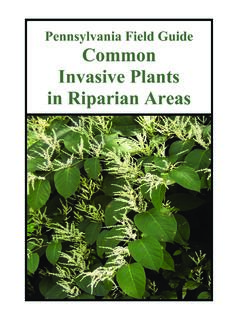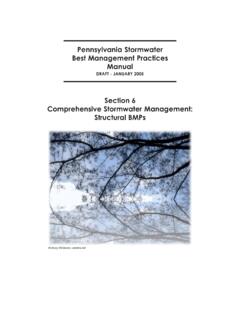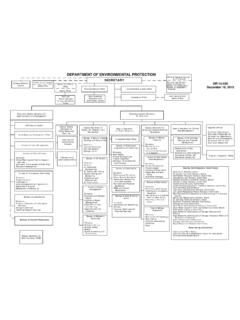Transcription of DEPARTMENT OF ENVIRONMENTAL PROTECTION …
1 DEPARTMENT OF ENVIRONMENTAL PROTECTION POLICY OFFICE DOCUMENT NUMBER: 012-0200-001 TITLE: Final Revision of Policy for Consideration of Local Comprehensive Plans and Zoning Ordinances in DEP Review of Permits for Facilities and Infrastructure EFFECTIVE DATE: March 6, 2004 AUTHORITY: Act 247 of 1968, as reenacted and amended by Act 170 of 1998, known as the Pennsylvania Municipalities Planning Code, 53 10101 et seq., as amended by Acts 67, 68 and 127 of 2000. Pertinent sections include Article VI, section and Article XI, section 1105(a)(2). Act 14 of 1984 [71 Section 510-5, (Adm. Code Section 1905-A). Cooperation with Municipalities]. POLICY: The DEPARTMENT of ENVIRONMENTAL PROTECTION (DEP) permit review process considers, and under certain conditions relies upon, comprehensive planning and zoning ordinances in our decision making process on authorizations related to facilities and infrastructure. This document is a substantial revision to the current policy in place since June 2002.
2 PURPOSE: The purpose of this policy is to provide direction and guidance to DEP staff, permit applicants and local and county governments for the implementation of Acts 67, 68 and 127 of 2000 in the administration of current DEP programs to avoid or minimize conflict with local land use decisions. This policy guidance addresses how DEP considers comprehensive planning and zoning ordinances in DEP s decision making process concerning the permitting of facilities and infrastructure; and when DEP relies upon comprehensive planning and zoning ordinances in DEP s decision-making process concerning the permitting of facilities and infrastructure. APPLICABILITY: DEP will apply this policy where it has regulatory and decision making discretion pursuant to legal authority and through the administration of DEP programs and regulations. This policy applies to DEP staff and applicants for certain DEP authorizations. Specifically, it applies to proposed projects for construction of facilities or infrastructure as listed in Appendix A of this policy.
3 This policy only applies to counties and local municipalities covered under the Municipalities Planning Code (MPC). The MPC does not apply to first and second class cities (Philadelphia and Pittsburgh) or first class counties (Philadelphia). 012-0200-001 / March 6, 2004 / Page i DEP s authority to rely on land use plan and zoning ordinance information in its permit decision making only applies to those projects located in areas of the state that meet conditions described in any of the following three categories: 1) Under Section (a) of the MPC: A) The municipality is located in a county where there is a county comprehensive plan; and B) The municipality has adopted a comprehensive plan or is a part of a multi-municipal comprehensive plan; and C) The county or municipality has enacted zoning ordinances; and D) The municipal zoning ordinance, the municipal comprehensive plan and county comprehensive plan are generally consistent as defined by Section 107 of the MPC.
4 2) Under Section (c) of the MPC: The municipality has adopted a joint zoning ordinance. 3) Under Section 1105 of the MPC: The municipality has entered into an implementing cooperative agreement and adopted zoning ordinances as described in Sections 1104 and 1105 of the MPC. DISCLAIMER: The policies and procedures outlined in this guidance are intended to supplement existing requirements. Nothing in the policies or procedures shall affect regulatory requirements. The policies and procedures herein are not an adjudication or a regulation. There is no intent on the part of DEP to give the rules in these policies that weight or deference. This document establishes the framework within which DEP will exercise its administrative discretion in the future. DEP reserves the discretion to deviate from this policy statement if circumstances warrant. PAGE LENGTH: 17 Pages LOCATION: Volume 1, Tab 5B DEFINITIONS: N/A 012-0200-001 / March 6, 2004 / Page ii I.
5 WHAT THIS POLICY IS ABOUT A. Acts 67, 68 and 127 of 2000 (Acts 67, 68 and 127) amended the Municipalities Planning Code to provide new tools for local governments to plan for and manage growth. Section 1105 of Act 67 of 2000 and Section of Act 68 directs that state agencies shall consider and may rely upon comprehensive plans and zoning ordinances when reviewing applications for the funding or permitting of infrastructure or facilities. B. Definitions Authorizations are approvals given by the DEPARTMENT to undertake a proposed project as required by state statute or regulation. These include permits, plan approvals, certificates, licenses and registrations. Comprehensive plans and zoning ordinances are county, municipal or multi-municipal comprehensive plans adopted under the MPC and zoning ordinances adopted under the MPC. A Designated Growth Area is a region within a county or counties described in a municipal or multi-municipal plan that preferably includes and surrounds a city, borough, or village and within which residential and mixed use development is permitted or planned for at densities of one unit to the acre or more, commercial, industrial and institutional uses are permitted or planned for, and public infrastructure services are provided or planned for.
6 EFACTS is the Environment, Facility, Application, Compliance Tracking System, developed to combine electronic data from legacy systems into one DEPARTMENT -wide database to provide the means for a holistic view of the clients and sites (including facilities) that DEP regulates. Facilities are buildings and other structures. The General Information Form (GIF) is a multi-page form used for most DEP applications. Its purpose is to facilitate coordination between different types of applications for the same project, to provide specific information that facilitates the entry of data into the eFACTS system, and collect other necessary information. A full application for a particular DEP authorization will generally consist of a GIF and additional forms related to the particular permit or other authorization. Infrastructure is permanent structures for transportation, sewer and water facilities, schools, parks, greenways and open space, electric and gas delivery systems and telecommunications networks.
7 II. WHICH AUTHORIZATIONS ARE AFFECTED BY THIS POLICY A. To determine which permit authorizations are covered by this policy, applicants need to answer two questions: 1) Is the authorization on the list found in Appendix A of this document; and 2) If it is an air program authorization, does the permit authorize the construction of facilities outside an existing permitted area? These questions are asked of 012-0200-001 / March 6, 2004 / Page 1 applicants on DEP s General Information Form (GIF), which is a required component of most DEP permit authorization applications. Section 3(A) discusses the GIF in more detail. The list provided in Appendix A of this document is based primarily upon the definition of facilities and infrastructure found in section I(B) of this policy. Any authorization not appearing on the list is not required to undergo the land use review outlined in this policy. B. Permits-by-rule are not subject to the requirements of this policy.
8 By definition, permits-by-rule are for facilities or activities that have a minor impact on the environment and therefore land use. Only one General Permit program, DEP s General Permit for stormwater construction activities (PAG-2), is covered by this policy with the exception of PAG-2 activities related to oil and gas wells. This exclusion exists because it is unlikely that oil and gas production activities will change current land use and access roads that may result are usually those that would not typically support increased residential, commercial or other development. All other General Permit programs are not covered at this time. In the future, DEP may consider the feasibility of integrating land use considerations pursuant to Acts 67, 68 and 127, into other General Permit programs on a case-by case basis. C. Authorizations under the Sewage Facilities Act and sewage planning program (Act 537), are not included in the list of affected authorizations.
9 The current consideration of land use within the 537 program already includes a mechanism to address land use. For that reason, reviews in the Act 537 planning program at this time will continue unchanged. For a description of the Act 537 program and its related land use process, see the Pennsylvania Sewage Facilities Act (35 Sections ), Section 5, Official Plans Subsection (d)(1), (2), (4), (5), (8), Section 7(b)(4), Section 10 (1), (2), (3) and Title 25, Chapter 71, Administration of Sewage Facilities Program. The following specific sections of Chapter 71 relate to coordination with local land use and other plans, how Act 537 Official plans and Official plan revisions must consider comments from appropriate official planning agencies at the local and county level and how sewage alternatives must be evaluated for consistency with respect to comprehensive plans: (b) (a)(3)(iv) (a)(5)(i)(A & D) (a)(5)(ii) D. Permit applications for railroad facilities and operations are not subject to the requirements of this policy because these facilities and operations are not subject to local land use control.
10 The local regulation of railroad facilities and operations by local governments is preempted by the federal Interstate Commerce Commission Termination Act of 1995, 49 Section 10501(b). 012-0200-001 / March 6, 2004 / Page 2 III. WHAT IS THE LAND USE REVIEW PROCESS? The land use review process established by this policy is designed to assist DEP in meeting its legal obligation under sections and 1105 of the MPC. The land use review policy applies to affected authorizations listed in Appendix A that were received on or after August 21, 2000, the effective date of Acts 67, 68 & 127. The land use review process has two major components: 1) The inclusion of land use questions as part of the permit application process ( on the DEP GIF or as part of the permit application form in programs that do not use the GIF) and 2) An opportunity for municipal and county comment to DEP on the accuracy of a permit applicant s answers to the referenced land use questions.













